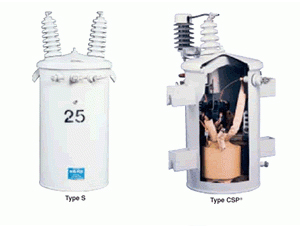Power Partners offers four basic transformer types: S, SP, CP and CSP. Together, they represent a wide range of protective capabilities to meet nearly every application. For transformers supplied with overcurrent protection, the user must assure coordination with system protective devices. Failure to do so will defeat the purpose of such protection. ISO 9001: 2008 Certified

Conventional S Transformers
Conventional S Transformers contains no protection equipment. Therefore, lightning, fault and overload protection for these transformers must be provided by purchaser-installed, auxiliary protective devices.
Conventional S Transformers with a Protective Link are the least expensive device mounted in the transformer to protect the system from a defective transformer. Whenever there is an internal failure, the resulting fault current will cause the protective link to blow, isolating the transformer from the primary feeder.
With Conventional S Transformers that have a Current-Limiting Fuse and Protective Link, both the current limiting fuse and the protective link are fuses working together to give full range transformer protection against fault-current. The protective link interrupts any low fault current while the current limiting fuse protects against fault currents which exceed the interrupting rating of the protective link.
Surge-Protecting (SP) Transformers
Surge-Protecting (SP) Transformers include transformer-mounted lightning arresters and internally-mounted high voltage protective links, but omit the internally-mounted low voltage circuit breaker. These transformers are used in locations where lightning is a problem. However, because the protective link protects the system only from outages due to internal transformer failure, overload protection, if desired, must be provided by external fuses.
Current-Protecting (CP) Transformers
Current-Protecting (CP) Transformers are equipped with the internally-mounted low-voltage circuit breaker and high voltage protective links, but omit the lightning arresters. These transformers are used in locations where lightning is not a problem. The arrester may be crossarm-mounted if surge protection is desired. The breaker and protective link are coordinated such that any fault or short circuit on the secondary side of the transformer will trip the breaker before the protective link operates, taking the load off the transformer before the core/coil is damaged.
Current-Protecting (CP) Transformers with a Current Limiting Fuse have the same characteristics as the type CP plus the ability to limit fault current to the transformer.
Self-Protected CSP Coordinated Protection Package
The Self-Protected CSP Coordinated Protection Package is available as an option on Power Partners overhead distribution transformers for increased protection against surge currents, short circuits, and overloads.
Standard Features
Protective Link:
- Removes an internally-faulted transformer from the primary line.
- Operates at 8 to 14 times normal full load current.
Secondary Circuit Breaker:
- Protects against overloads and external short circuits.
- Coordinated with protective link, trips on an external short or overload before the link blows, and only if the overload is large or continuous.
- If overload is small or temporary, a load management light signals the need for change-out to a larger unit for more optimized transformer loading.
MOV Polymer Arrester:
- Provides protection from lightning and switching surges.
- The large bz coordinated with the impulse strength of the coil windings.
Optional partial-range current limiting fuse (in series with protective link):
- Limits the maximum current in the circuit.
- Reduces current to zero in less than one-half cycle.
- Minimizes the possibility of eventful failure.
The CSP protection package is available on single phase and three phase overhead distribution transformers in the following ratings:
- Single Phase, LV 120/240, 10-100 kVA
- Single Phase, LV 240/480, 10-167 kVA
- Three Phase, 30-150 kVA
Class Designations
Type CSP, above 5 kV, 10-100 kVA
Class A: Two fully-insulated high voltage bushings, two arresters, two protective links and external breaker handle. Suitable for application on either wye or delta distribution systems. Single-position pole mounting in accordance with latest ANSI standards.
Class B-1: Two fully-insulated high voltage bushings, one arrester, two protective links and external breaker handle. Normally applied on solidly grounded systems.
Class B-2: One fully-insulated high voltage bushing, one arrester, one protective link and external breaker handle. Suitable only for application on solidly grounded distribution systems. Single-position pole mounting in accordance with latest ANSI standards.
Class B-3: Same as class B-2 except with two-position mounting.
Type CSP, 5 kV and below, 10-100 kVA
Similar to Type CSP above 5 KV except:
- Sidewall-mounted primary bushings.
- Class B-2 and B-3 not available.
Type S, above 5 kV, 10-500 kVA
Class A: Two fully-insulated high voltage bushings, suitable for application on either wye or delta distribution systems. Single-position pole mounting in accordance with the latest ANSI standards.
Class B-2: One fully-insulated high voltage bushing, suitable only for application on solidly grounded distribution systems. Single-position pole mounting in accordance with the latest ANSI standards.
Class B-3: Same as class B-2 except with two-position mounting.
Type S, 5 kV and below, 10-500 kVA
Similar to Type S, above 5 kV, except:
- Sidewall-mounted primary bushings.
- Only Class A is available.

